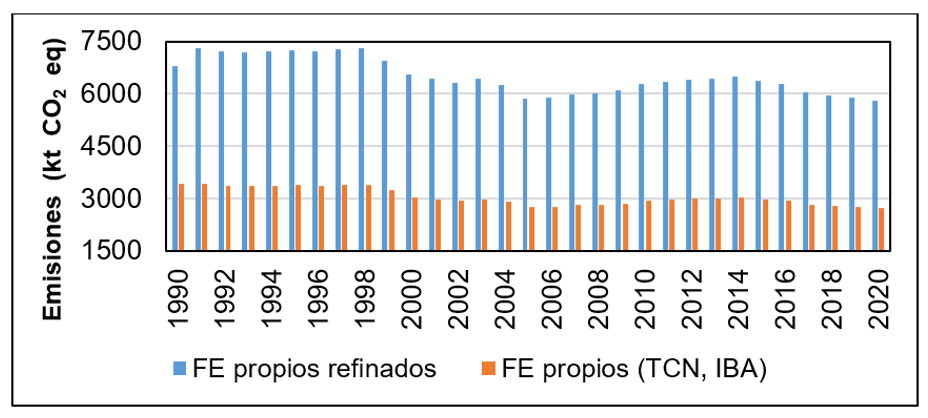Greenhouse gas from the livestock sector in Cuba for the period 1990-2020
Main Article Content
Abstract
The objective of this research was to estimate greenhouse gas emissions from livestock in Cuba in the period 1990-2020. The methodology used is based on the 2006 IPCC Guidelines. CH4 emissions were estimated for the Enteric Fermentation subcategory, and CH4 and N2O emissions for the Manure Management subcategory. The activity data were obtained from the Annual Statistical Yearbooks published by the National Office of Statistics and Information. Characteristic parametric data of bovine livestock in the country were available, provided by the Ministry of Agriculture. These data made possible to calculate, for each type of cattle, country-specific emission factors and the annual average nitrogen excretion, to estimate CH4 emissions from Enteric Fermentation and Manure Management, and N2O emissions from Manure Management, respectively. Default emission factors from the 2006 IPCC Guidelines were used for the remaining species. Emissions for both subcategories in 2020 decreased with respect to the 1990 base year, as a consequence of reduced livestock populations. Enteric fermentation was the most relevant subcategory with 81.2% of greenhouse gas emissions from the Livestock category. Cattle constituted the only significant subcategory of emissions from Enteric Fermentation and Manure Management.
Downloads
Article Details

This work is licensed under a Creative Commons Attribution-NonCommercial 4.0 International License.
Those authors who have publications with this journal accept the following terms of the License Attribution-NonCommercial 4.0 International (CC BY-NC 4.0):
You are free to:
- Share — copy and redistribute the material in any medium or format
- Adapt — remix, transform, and build upon the material
The licensor cannot revoke these freedoms as long as you follow the license terms.
Under the following terms:
- Attribution — You must give appropriate credit, provide a link to the license, and indicate if changes were made. You may do so in any reasonable manner, but not in any way that suggests the licensor endorses you or your use.
- NonCommercial — You may not use the material for commercial purposes.
- No additional restrictions — You may not apply legal terms or technological measures that legally restrict others from doing anything the license permits.
The journal is not responsible for the opinions and concepts expressed in the works, they are the sole responsibility of the authors. The Editor, with the assistance of the Editorial Committee, reserves the right to suggest or request advisable or necessary modifications. They are accepted to publish original scientific papers, research results of interest that have not been published or sent to another journal for the same purpose.
The mention of trademarks of equipment, instruments or specific materials is for identification purposes, and there is no promotional commitment in relation to them, neither by the authors nor by the publisher.
References
Cisneros, L.M. (2018). Inventario de gases de efecto invernadero en la producción de ganado de carne en la Escuela Agrícola Panamericana, Zamorano. Tesis para optar al título de Ingeniera en Ambiente y Desarrollo en el Grado Académico de Licenciatura. Zamorano, Honduras.
Du Toit, C. J. L., Meissner, H. H., & Van Niekerk, W. A. (2013). Direct methane and nitrous oxide emissions of South African dairy and beef cattle. South African Journal of Animal Science, 43(3), 320-339.
FAO (2014). Agricultura, Silvicultura y otros Usos de la Tierra. Emisiones por fuentes y absorciones por sumideros. Organización de las naciones unidas para la alimentación y la agricultura, Roma.
Hernández, O. A. (2020). Emisión de gases de efecto invernadero en unidades de producción bovina en Chiapas, México. Tesis de Maestría en Ciencias en Producción Agropecuaria Tropical. Universidad Autónoma de Chiapas. Facultad de Ciencias Agronómicas. Chiapas, México.
IPCC (2006). IPCC Guidelines for National Greenhouse Gas Inventories, Prepared by the National Greenhouse Gas Inventories Programme, Eggleston H.S., Buendia L., Miwa K., Ngara T. y Tanabe K. (eds). Published: IGES, Japan.
Moreno, H. W; Torres, C. F; Gómez, E. L; Manrique, D. L; Sánchez, L. A. (2021). Cálculo de factores de emisión de metano (CH4) entérico y de gestión de estiércol para ganado bovino en Colombia por metodología TIER 2. Boletín técnico: N° 1 - enero 2021. Grupo de Cambio Global - Subdirección de estudios Ambientales (SEA) – IDEAM. Bogotá, Colombia.
Nieto, M.I.; Guzmán, M.L.; Steinaker, D. (2014). Emisiones de gases de efecto invernadero: simulación de un sistema ganadero de carne típico de la región central Argentina. Revista de Investigaciones Agropecuarias, vol. 40, núm. 1, pp. 92-101. Instituto Nacional de Tecnología Agropecuaria. Buenos Aires, Argentina.
República de Cuba (2020). Tercera Comunicación Nacional a la Convención Marco de las Naciones Unidas sobre Cambio Climático. Ministerio de Ciencia, Tecnología y Medio Ambiente. La Habana, República de Cuba.
Valdés A., R. Manso, R. Manrique, E. Carrillo, C. Sosa, A. León, A. V. Guevara, C. González, D. Boudet, M. Amárales, R. Biart, I. López, D. Pérez, S. F. Pire, L. Cuesta, A. Mercadet, A. Álvarez (2014). Emisiones y Remociones de Gases de Invernadero en Cuba. Reporte Actualizado para el Período 1990 – 2008, CITMA/AMA/Instituto de Meteorología. La Habana.
Wayne, D. (1991). Estadísticas no paramétricas y de libre distribución. En: Bioestadística. Base para el análisis de las ciencias de la salud. (pp.503 – 557). México, D.F.: Ed. Simusa.
Zuñiga, N. (2016). Estimación de las emisiones en bovinos en los sistemas de producción lechera en pequeña escala a través del factor de conversión de metano. Tesis para optar al Grado de Doctor en Ciencias Agropecuarias y Recursos Naturales. Universidad Autónoma del Estado de México. México.

